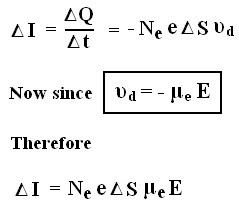Field Theory - Conduction And Convection Current Density....
CONVECTION CURRENT DENSITY:
- Convection current occurs in insulators or dielectrics such as liquid, vacuum and rarified gas.
- Convection current results from motion of electrons or ions in an insulating medium.
- Since convection current doesn’t involve conductors, hence it does not satisfy ohm’s law.
- Consider a filament where there is a flow of charge ρv at a velocity u = uy ay.
- Hence the current is given as:
Where uy is the velocity of the moving electron or ion and ρv is the free volume charge density.
- Hence the convection current density in general is given as:
J = ρv u
CONDUCTION CURRENT DENSITY:
- Conduction current occurs in conductors where there are a large number of free electrons.
- Conduction current occurs due to the drift motion of electrons (charge carriers).
- Conduction current obeys ohm’s law.
- When an external electric field is applied to a metallic conductor, conduction current occurs due to the drift of electrons.
- The charge inside the conductor experiences a force due to the electric field and hence should accelerate but due to continuous collision with atomic lattice, their velocity is reduced.
- The net effect is that the electrons moves or drifts with an average velocity called the drift velocity (υd) which is proportional to the applied electric field (E).
- Hence according to Newton’s law, if an electron with a mass m is moving in an electric field E with an average drift velocity υd, the the average change in momentum of the free electron must be equal to the applied force (F = - e E).
- The drift velocity per unit applied electric field is called the mobility of electrons (μe).
υd = - μe E
where μe is defined as:
- Consider a conducting wire in which charges subjected to an electric field are moving with drift velocity υd.
- Say there are Ne free electrons per cubic meter of conductor, then the free volume charge density(ρv) within the wire is
ρv = - e Ne
- The charge ΔQ is given as:
ΔQ = ρv ΔV = - e Ne ΔS Δl = - e Ne ΔS υd Δt
- The incremental current is thus given as:
- The conduction current density is thus defined as:
where σ is the conductivity of the material.
- The above equation is known as the Ohm’s law in point form and is valid at every point in space.
- In a semiconductor, current flow is due to the movement of both electrons and holes, hence conductivity is given as:
σ = ( Ne μe + Nh μh )e
ALSO READ:
- Gauss's Law - Theory.
- Gauss's Law - Application To a Point charge.
- Gauss's Law - Application To An Infinite Line Charge.
- Gauss's Law - Application To An Infinite Sheet Charge.
- Gauss's Law - Application To a Uniformly Charged Sphere.
- Numericals / Solved Examples - Gauss's Law.
- Scalar Electric Potential / Electrostatic Potential (V).
- Relationship Between Electric Field Intensity (E) and Electrostatic Potential (V).
- Electric Potential Due To a Circular Disk.
- Electric Dipole.
- Numericals / Solved Examples - Electric Potential and Electric Dipole.
- Energy Density In Electrostatic Field / Work Done To Assemble Charges.
- Numericals / Solved Examples - Electrostatic Energy and Energy Density.
- Numericals / Solved Examples - Gauss's law...
- Short Notes/FAQ's
Your suggestions and comments are welcome in this section. If you want to share something or if you have some stuff of your own, please do post them in the comments section.









Very useful information, really helped me for an exam.Thank you
ReplyDeletetq
ReplyDeletethank u very much.it helped me a lot for my exam.
ReplyDeletethanx a lot...
ReplyDeletethanks..
ReplyDeletehelped a lot in my exams..
very very thanks..
ReplyDeletethanks a lot.good job,sir!
ReplyDeletethanks 4 ur information
ReplyDeletetq
ReplyDeletegood explanation
ReplyDelete